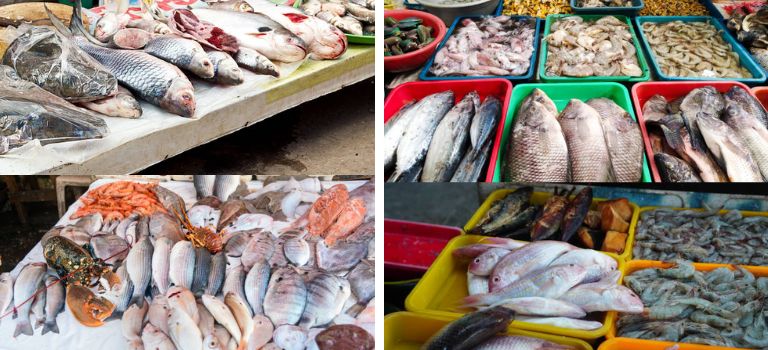From the glistening shores of tropical paradises to the rugged coastlines of northern climes, the world’s oceans have long captivated our imaginations and nourished our souls. In recent years, the world has witnessed a remarkable shift towards sustainable practices in various industries, and the realm of seafood is no exception. As concerns about overfishing, pollution, and habitat degradation threaten the health of our oceans and seas, consumers, businesses, and policymakers are increasingly embracing the concept of sustainable seafood. This movement isn’t just about protecting our oceans; it’s about ensuring delicious, healthy seafood for generations to come.

From Exploitation to Exploration: Shifting the Seascape
For decades, traditional fishing practices often prioritized short-term gains over long-term sustainability. Imagine vast fishing fleets casting enormous nets, indiscriminately sweeping up everything in their path. This overfishing depletes fish populations, disrupts delicate ecosystems, and jeopardizes the future of our oceans.
Thankfully, a shift in mindset is underway. Sustainable seafood practices prioritize responsible fishing methods that allow fish populations to replenish naturally. Think smaller, more selective fishing techniques that minimize bycatch (unwanted animals caught unintentionally) and prioritize the health of the marine environment. Imagine divers meticulously harvesting scallops by hand or smaller, community-run fishing operations using traditional, low-impact methods.
Embracing Sustainable Seafood: A Path to Preservation
At the heart of the sustainable seafood movement lies a simple yet profound philosophy: to meet our present needs without compromising the ability of future generations to meet their own. This ethos recognizes the delicate balance that must be struck between human consumption and the preservation of marine ecosystems, ensuring that our ocean’s bounty remains a renewable and abundant resource for centuries to come.
Furthermore, sustainable seafood practices encompass a wide range of initiatives, from responsible fishing techniques that minimize bycatch and habitat damage, to aquaculture methods that prioritize environmental stewardship and ethical treatment of marine life. Additionally, it is a holistic approach which recognizes that what we do does not only affect the ocean but also affects the communities which live near to the oceans. Moreover, it portrays the significance of realizing the symbiosis between personal acts and their repercussions on the marine ecosystems as well as the coastal economy.
Sustainable Seafood Movement
One of the cornerstones of the sustainable seafood movement is the notion of traceability and transparency. In an age where consumers are increasingly conscious of the origins and impact of their food choices, the ability to trace seafood from ocean to plate has become paramount. Through initiatives such as the Marine Stewardship Council (MSC) and the Aquaculture Stewardship Council (ASC), consumers can now make informed decisions, opting for seafood products that carry the hallmark of sustainability and responsible sourcing.
Here are some key players making a splash in the sustainable seafood scene:
- The Marine Stewardship Council (MSC): Look for the blue MSC eco-label on seafood products. This independent organization certifies fisheries that meet rigorous sustainability standards.
- The Aquaculture Stewardship Council (ASC): As demand for seafood rises, responsible aquaculture (fish farming) becomes increasingly important. The ASC certifies responsible fish farms that minimize environmental impact.
- Local and Seasonal: Opting for locally caught, seasonal seafood is a fantastic way to support sustainable practices. Smaller, local fisheries often employ more sustainable methods and offer incredible freshness.
- Community Supported Fisheries (CSFs): These programs connect consumers directly with local fishermen. You subscribe to a “share” and receive a regular delivery of fresh, sustainably caught seafood.
- Aquaponics: This innovative system combines fish farming with hydroponics (growing plants without soil). The fish waste provides nutrients for the plants, while the plants filter the water for the fish. It’s a closed-loop system that minimizes waste and promotes resource efficiency.
- Cellular Agriculture: This emerging technology involves growing seafood meat in a lab setting using real fish cells. While still in its early stages, it holds immense potential for reducing pressure on wild fish populations.
Sustainable Seafood and Community Empowerment
Beyond its environmental benefits, the sustainable seafood movement has also emerged as a powerful force for community empowerment and economic development. In coastal regions around the world, traditional fishing communities are embracing sustainable practices, recognizing the long-term benefits of preserving their marine resources and safeguarding their livelihoods for generations to come.
Envision a secluded island village, where artisanal fishermen partner with local cooperatives and NGOs, implementing responsible fishing practices like using selective gear and adhering to catch limits – fostering sustainability, community pride, ownership, and empowering them as stewards of their marine resources.
Sustainable Seafood on Your Plate: Culinary Delights
For many, the allure of sustainable seafood extends beyond its environmental and social implications; it is also a celebration of culinary artistry and gastronomic delight. As chefs and culinary innovators embrace the principles of sustainability, they are crafting dishes that showcase the natural flavors and textures of responsibly sourced seafood, elevating these oceanic delicacies to new heights of culinary excellence.
Picture enjoying the pure flavor of line-caught wild salmon or savoring sustainably farmed oysters, each a testament to the link between food choices and ocean health.
Conclusion: A Legacy of Abundance
As we navigate the currents of change, embracing sustainable seafood practices is not merely a trend or a passing fancy; it is a profound commitment to preserving the ocean’s bounty for generations to come. By consciously choosing to support responsible fishing and aquaculture methods, we become stewards of the marine ecosystems that have sustained humanity for millennia, ensuring that our children and grandchildren can marvel at the same wonders and feast on the same delicacies that we cherish today.
Let’s harmonize our voices for ocean conservation, urging seafood suppliers to prioritize traceability and ethical sourcing. Enjoy regional cuisine with organic ingredients, knowing your choices support ocean health. And unlike other movements, the rise of sustainable seafood symbolizes our commitment to preserving ocean resources and marine life for a prosperous future

